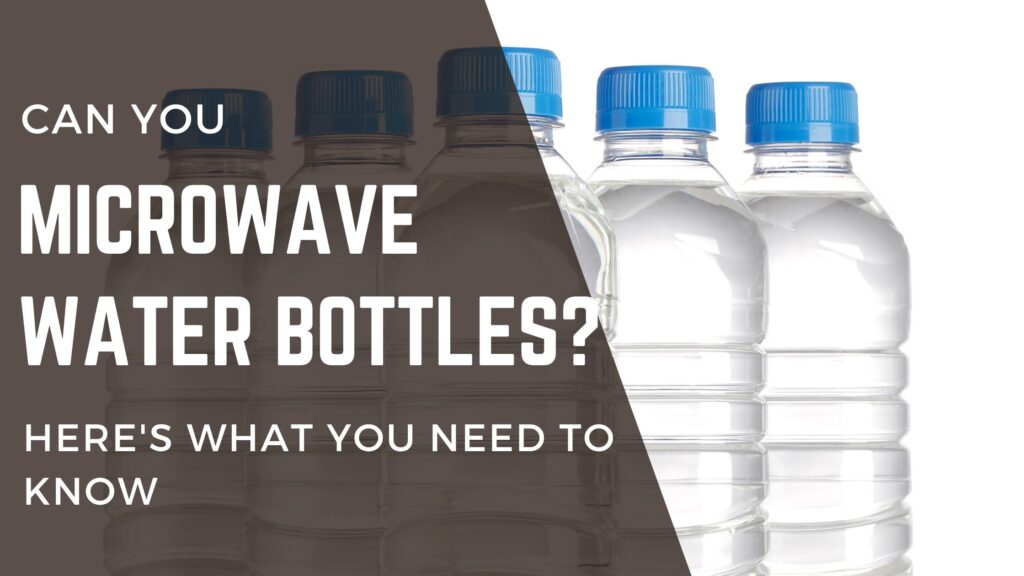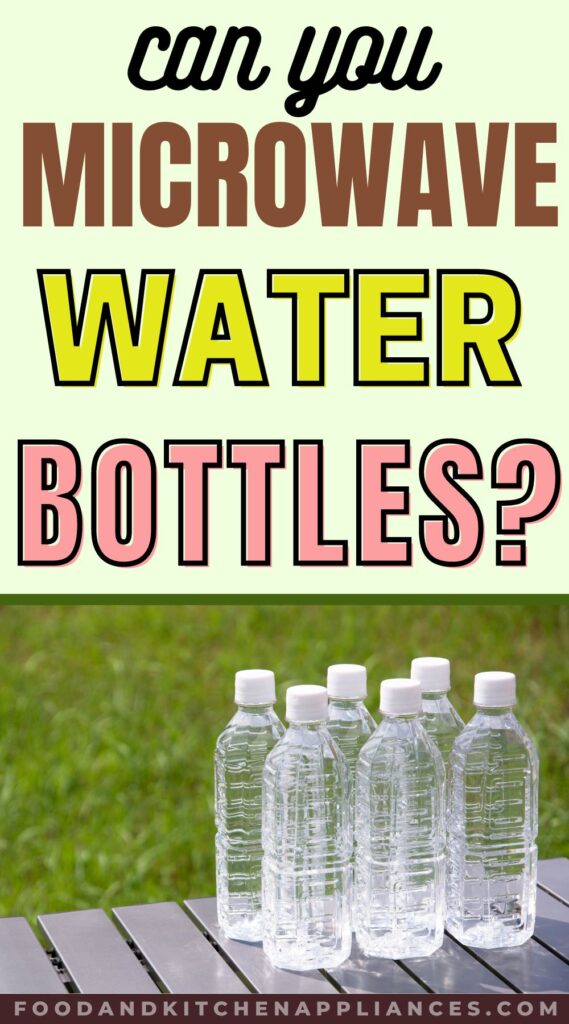Can you microwave water bottles? This is a question that many people ask themselves when they need to heat water quickly. While it may seem like a convenient solution, knowing whether it is safe to microwave water bottles is essential.

Can you microwave water bottles?
The answer is not a straightforward yes or no. It depends on the type of water bottle you have. Some water bottles are made of not microwave-safe materials, and heating them in the microwave can cause them to melt or release harmful chemicals. Other water bottles are specifically designed to be microwave-safe and can be safely heated up in the microwave.
Understanding Microwaves and Plastic
How Microwaves Work
Microwaves are a type of electromagnetic radiation that is used to heat food in a microwave oven. The microwaves cause the food’s water molecules to vibrate, generating heat and cooking the food.
Microwaves are absorbed by materials that contain water, such as food, but some types of plastic also absorb them. When microwaves are absorbed by plastic, the plastic can become hot and melt or release chemicals.
Plastic in the Microwave
Not all types of plastic are safe to use in the microwave. Some plastics can release harmful chemicals when heated, harming your health.
To determine if a plastic container is safe to use in the microwave, look for a microwave-safe symbol on the container. This symbol looks like a square with some wavy lines inside it.
If a plastic container has no microwave-safe symbol, avoiding using it in the microwave is best. Instead, use a glass or ceramic container, which is safe to use in the microwave.
Potential Risks of Microwaving Water Bottles
Chemical Leaching
When you microwave a water bottle, there is a risk of chemicals leaching into the water. Some water bottles are made from a type of plastic called polyethylene terephthalate (PET), which is generally considered safe for single-use purposes.
However, when heated, PET can release chemicals such as antimony, a toxic substance that can cause nausea, vomiting, and diarrhea.
In addition, some water bottles may contain other chemicals, such as bisphenol A (BPA) or phthalates, which can also leach into the water when heated.
Physical Deformities
In addition to the risk of chemical leaching, microwaving water bottles can cause physical deformities. When heated, the plastic can become soft, pliable, and even melt. This can cause the bottle to warp or deform, making it difficult to hold or drink.
Sometimes, the bottle may burst or explode, which can be dangerous and cause injury.
This is particularly true if the bottle has a tight-fitting cap or is sealed in some other way, which can create pressure and cause it to rupture.
To avoid these potential risks, it is best to avoid microwaving water bottles altogether. Instead, use a microwave-safe container made from glass or ceramic to heat your water.
If you must use a plastic container, ensure it is labeled microwave-safe and follow the manufacturer’s instructions carefully.
Using a water bottle as a heat pack
If you only want to heat water as a heat pack, you can do so in the microwave. As you are not ingesting anything, the chemicals leached into water during heating will not enter your body.
While eating, keep the bottle upright while heating and loosen the lid, or it may burst inside the microwave.
Safe plastics you can microwave
When microwaving plastic, looking for containers labeled as “microwave-safe” or those specifically designed for microwave use is essential. These containers are made from plastics that are considered safe for use in the microwave.
The following types of plastic are generally considered microwave-safe:
- Polypropylene (PP): This type of plastic is often used for food storage containers, including some microwave-safe bowls, plates, and cups. It has a high melting point and is generally considered safe for use in the microwave.
- High-Density Polyethylene: HDPE is another type of plastic commonly used for food containers, such as milk jugs and some plastic food storage containers. It is considered microwave-safe and has a high heat tolerance.
- Low-Density Polyethylene (LDPE): LDPE is often used for plastic bags, wraps, and squeeze bottles. While LDPE is generally considered microwave-safe, it is best to use it for short heating durations and avoid high heat.
Always check the labels and packaging of plastic containers to ensure they are labeled microwave-safe.
Safe Ways to Heat Water
Using a Kettle
A kettle is a safe and easy way to heat water. Fill the kettle with the desired amount of water and place it on the stove. Turn on the heat and wait for the water to boil.
Once the water has reached boiling point, turn off the heat and pour the water into a mug or container.
Stovetop Method
Another safe way to heat water is by using a pot on the stovetop. Fill the pot with the desired amount of water and place it on the stove. Turn on the heat and wait for the water to boil.
Once the water has reached boiling point, turn off the heat and pour the water into a mug or container.
It’s important to note that you should never leave the pot unattended when using the stovetop method. Or as I do, you would forget that you have put something on the stovetop.
Alternatives to Plastic Water Bottles
If you’re concerned about the impact of plastic on the environment and your health, you might be looking for alternatives to plastic water bottles. Fortunately, many options are available, including glass and stainless steel bottles.
Glass Bottles
Glass bottles are a popular alternative to plastic because they are reusable, durable, and don’t contain harmful chemicals. They are also easy to clean and don’t retain flavors or odors.
However, glass is fragile and can break if dropped, so handle them carefully.
When choosing a glass bottle, look for one made from borosilicate glass, which is more resistant to thermal shock than regular glass.
Some popular brands of glass water bottles include Lifefactory, BKR, and Glasstic.

Frequently Asked Questions
How long can you safely microwave a plastic water bottle?
You should not microwave a plastic water bottle for more than 30 seconds. If you need to heat it up longer, doing it in 10-second intervals is recommended.
Overheating the bottle can cause it to melt or release harmful chemicals into the water.
Can you heat up a water bottle in the microwave?
Yes, you can heat a water bottle in the microwave. However, you should be careful not to overheat it and ensure the bottle is microwave-safe.
Is it safe to microwave a water bottle filled with liquid?
Yes, it’s safe to microwave a water bottle filled with liquid. However, the water bottle should be microwave safe and don’t overheat to avoid any accidents.
What are the dangers of microwaving a water bottle?
The dangers of microwaving a water bottle include overheating, melting, and releasing harmful chemicals into the water. Additionally, if the bottle has a cap, it can cause pressure to build up and explode.
Can microwaving a water bottle cause it to explode?
Yes, microwaving a water bottle can cause it to explode if it has a cap on it. The pressure from the heated liquid can build up and cause the bottle to burst.
How do you safely warm up a water bottle in the microwave?
To safely warm a water bottle in the microwave, ensure it’s microwave-safe and remove the cap. Heat it up in 10-second intervals, checking the temperature frequently to ensure it’s not overheating.
How to melt marshmallows in the microwave?